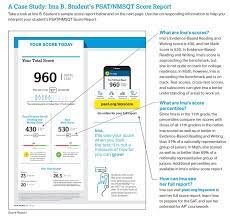The PSAT Report, by Grumpy Old Teacher
Ima B., an unfortunate choice for a student pseudonym.
You have to hand it to the College Board. Given that colleges are giving up on SAT scores as a meaningful input into admission decisions, the College Board has worked to add value to the standardized testing it markets to high school students and their families as well as middle schoolers with the PSAT 8/9 test.
If you want to see an upbeat, cheery-voiced video that promotes the wonders of the PSAT, you can watch it here.
If you’d rather have the executive summary to the blog post, it’s rather simple: the College Board understands that its target audience has changed and that to continue selling its products, it has to deliver a value-added model. (Pun intended!)
Paper reports are out. No more mail for you, eager students, you need to log into your College Board account and read it online. Most will because, just like teachers, even if they think the exercise pointless and stupid, they still want to see how they did.
The summary page delivers the number, the overall score that is a sum of the reading … oops, excuse Grumpy Old Teacher (GOT), the Evidence-Based Reading and Writing score, which the College Board abbreviates as EBRW … and math scores. Those individual numbers are also given, and then the College Board adds detail. They show a range for the student because most students are taking a PSAT product multiple times, perhaps beginning in 8th grade, and continuing year after year until they move into the big time, the 11th grade PSAT/NMSQT that gives them the chance to qualify for a one-time freshman scholarship of $2,500.
Nothing to sneeze at, but it brings up collateral issues like many college scholarships are for the first year only, leaving a continuing sophomore scrambling to replace the funding, most of the time borrowing to finance the tuition. The scholarship is merit-based, which means the students who scored the highest and then went through a grueling application process to move from semi-finalist (score-based) to finalist (panel selected.)
About 16,000 are asked to apply, and that gets winnowed down to 8,000 finalists, and that gets winnowed down to about 3,000 winners. Lordy, lordy, what we put kids through even as we ignore the racial bias that has been present in the SAT from the beginning. Fellow blogger Steven Singer explains it well.
Let’s go back to the report. The PSAT gives the range in which a student has been scoring because they have been taking this test multiple times. The data point should drift upward because the reporting scales shift as well. From the PSAT 8/9 to the SAT, the min-max moves from 120-720 (PSAT 8/9) to 160-760 (PSAT 10 & PSAT/NMSQT) to 200-800 (SAT.)
Students are given a percentile rank, not based on actual test results, but based on research samples that attempt to fix how scores would look if all students at a given grade level took the PSAT.
With this information at hand, the score report now delivers a deep dive into … something. Students are given subscores and cross-scores that attempt to tell them their strengths and weaknesses and point them to areas of focus.
Students are prompted to connect their results to Khan Academy and spend their spare time practicing for the SAT. (Take that, Tik Tok!)
Students are given an analysis of which Advanced Placement (AP) exams/courses they would do well at and that they would … cough, cough, oh, I’m gonna do it … suck at.
Students can look at the College Board’s ideas about what majors they should decide upon and what careers would fit them.
Students can go back, read all the test questions, look at the answer choices presented, and see what they chose and what the correct answer is. Kudos, sincere kudos, to College Board for this one. They understand that test results are meaningless if no one can go back to the actual test and review the performance.
Looking at you, Pearson et al. Your cost-cutting secrecy over test questions makes annual state testing pointless. How is a teacher supposed to know what a Level 2 means without having access to the test and questions to pinpoint where a child struggled?
In GOT’s day, there was no advance warning. One day, we were marched to the cafeteria, sat down at the tables, and handed a test to take. GOT supposes he eventually got a piece of paper with the results, but no one ever talked about it or what it meant.
Now, we take a half-hour of the school day so all teachers could have students access their score reports, go over all the resources and value-added, online features, and encourage them to do what few kids ever do … study and practice on their own.
The College Board has taken a test and turned it into an experience. The effort could not have been cheap, but when the relevancy of one’s products is being questioned by the market, it’s time to pull the new, improved, advanced version off the shelf with slick sales pitches built-in–here are our AP tests you should take!
This points to the existential crisis for the College Board. How do they keep teenagers taking their tests? After all, would you voluntarily go take a driving test if your state didn’t require you to pass it before you can operate a motor vehicle on public roads? Somehow, GOT doesn’t think the promise that you would get a report identifying your strengths and weaknesses as a driver would motivate you.

